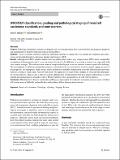Files in this item
WHO/ISUP classification, grading and pathological staging of renal cell carcinoma : standards and controversies
Item metadata
| dc.contributor.author | Warren, Anne Y. | |
| dc.contributor.author | Harrison, David | |
| dc.date.accessioned | 2018-09-06T15:30:06Z | |
| dc.date.available | 2018-09-06T15:30:06Z | |
| dc.date.issued | 2018-12 | |
| dc.identifier | 255749918 | |
| dc.identifier | 337ffa15-dc7d-41ca-b50c-c70a1f63bec2 | |
| dc.identifier | 85052147888 | |
| dc.identifier | 000452271200004 | |
| dc.identifier.citation | Warren , A Y & Harrison , D 2018 , ' WHO/ISUP classification, grading and pathological staging of renal cell carcinoma : standards and controversies ' , World Journal of Urology , vol. 36 , no. 12 , pp. 1913-1926 . https://doi.org/10.1007/s00345-018-2447-8 | en |
| dc.identifier.issn | 0724-4983 | |
| dc.identifier.uri | https://hdl.handle.net/10023/15983 | |
| dc.description.abstract | Purpose: Pathological parameters assessed on biopsies and resection specimens have a pivotal role in the diagnosis, prognosis and management of patients with renal cell carcinoma (RCC). Methods: A non-systematic literature search was performed, updated to January 2018, to identify key standards and controversies in the pathological classification, grading and staging of RCC. Results: Although most RCCs exhibit characteristic morphology that enables easy categorisation, RCCs show considerable morphological heterogeneity and it is not uncommon for there to be difficulty in assigning a tumour type, especially with rarer tumour subtypes. The differentiation between benign and malignant oncocytic tumours remains a particular challenge. The development of additional immunohistochemical and molecular tests is needed to facilitate tumour typing, because of the prognostic and therapeutic implications, and to enable more reliable identification of poorly differentiated metastatic tumours as being of renal origin. Any new tests need to be applicable to small biopsy samples, to overcome the heterogeneity of renal tumours. There is also a need to facilitate identification of tumour types that have genetic implications, to allow referral and management at specialist centres. Digital pathology has a potential role in such referral practice. Conclusion: Much has been done to standardise pathological assessment of renal cell carcinomas in recent years, but there still remain areas of difficulty in classification and grading of these heterogeneous tumours. | |
| dc.format.extent | 14 | |
| dc.format.extent | 779787 | |
| dc.language.iso | eng | |
| dc.relation.ispartof | World Journal of Urology | en |
| dc.subject | Grading | en |
| dc.subject | Pathology | en |
| dc.subject | Renal cell carcinoma | en |
| dc.subject | Review | en |
| dc.subject | Staging | en |
| dc.subject | RB Pathology | en |
| dc.subject | RZ Other systems of medicine | en |
| dc.subject | Urology | en |
| dc.subject.lcc | RB | en |
| dc.subject.lcc | RZ | en |
| dc.title | WHO/ISUP classification, grading and pathological staging of renal cell carcinoma : standards and controversies | en |
| dc.type | Journal item | en |
| dc.contributor.institution | University of St Andrews. School of Medicine | en |
| dc.contributor.institution | University of St Andrews. Cellular Medicine Division | en |
| dc.identifier.doi | 10.1007/s00345-018-2447-8 | |
| dc.description.status | Peer reviewed | en |
This item appears in the following Collection(s)
Items in the St Andrews Research Repository are protected by copyright, with all rights reserved, unless otherwise indicated.

